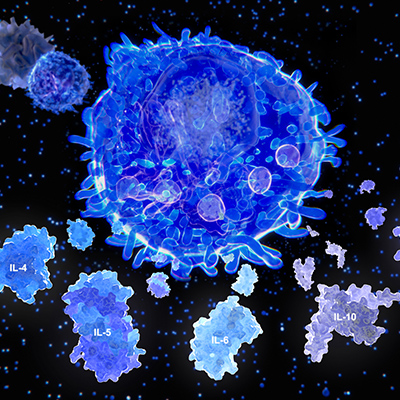July 17, 2020 -- Scientists have developed a biomimetic vaccine-delivery strategy based on an innate immune function of red blood cells that can deliver vaccine nanoparticles to the spleen, according to a research article published in the Proceedings of the National Academy of Sciences on July 14. Their approach may lead to using the cells as vaccine delivery vehicles, including for COVID-19.
Investigators harnessed the natural ability of red blood cells to capture certain pathogens on their surfaces and present them to the immune cells in the spleen. By using the cells to deliver antigens to the spleen's antigen-presenting cells (APCs), this platform technology effectively generated an immune response.
The technology, called erythrocyte-driven immune targeting, involves using antigenic nanoparticles from the surface of erythrocytes that present to the APCs in the spleen. In experiments, the technology successfully slowed the growth of cancerous tumors in mice.
It could also be used as a biocompatible adjuvant for different vaccines, according to the researchers at Harvard University's Wyss Institute for Biologically Inspired Engineering and the John A. Paulson School of Engineering and Applied Sciences, as well as colleagues at the University of Pennsylvania's Perelman School of Medicine.
Hitchhiking nanoparticles
Erythrocytes capture immune complexes and bacteria in circulation on their surface and hand them to Kupffer cells in the liver and APCs in the spleen without themselves being consumed by the APCs. In the past, nanoparticles have been attached to the surface of erythrocytes or encapsulated within them for therapeutic applications. Now, investigators combined the two to hand off nanoparticles to the spleen.
The scientists selected ovalbumin, known to cause a mild immune response, as a model antigen, which they capped on the surface of 200-nm polystyrene carboxylate to create protein-capped nanoparticles that were attached to the erythrocytes.
They engineered the nanoparticles to hitchhike with the erythrocytes by making the nanoparticles adsorb on the erythrocyte surface to initiate contact, and by having the erythrocyte membrane spread around the nanoparticles to enhance adhesion strength.
By engineering the number density of adsorbed nanoparticles -- the number of nanoparticles loaded on each erythrocyte -- the researchers forced delivery to the spleen rather than the lungs, traditionally the target of erythrocyte-mediated delivery systems.
A ratio of 300 nanoparticles per erythrocyte generated the greatest number of nanoparticles bound to the cells, retained about 80% of the nanoparticles when the cells were exposed to shear stresses found in lung capillaries (enabling them to avoid uptake in the lungs rather the in the spleen), and caused the moderate expression of the lipid molecule phosphatidyl serine (PS) on the cells' membranes, wrote the investigators.
"A high level of PS on red blood cells is essentially an 'eat me' signal that causes them to be digested by the spleen when they are stressed or damaged, which we wanted to avoid. We hoped that a lower amount of PS would instead temporarily signal 'check me out' to the spleen's APCs, which would then take up the red blood cells' antigen-coated nanoparticles without the cells themselves getting destroyed," explained Anvay Ukidve, a co-author of the paper and graduate student at Harvard University, in a statement.
The scientists injected red blood cells coated with their nanoparticles into mice, then tracked where they accumulated in their bodies. About 20 minutes after injection, more than 99% of the nanoparticles had been cleared from the animals' blood. More nanoparticles were present in their spleens than lungs.
The higher nanoparticle accumulation in the spleen persisted for up to 24 hours. The number of red blood cells in the circulation remained unchanged, showing that the red blood cells had successfully delivered their cargoes to the spleen without being destroyed, the researchers indicated.
Copyright © 2020 scienceboard.net








